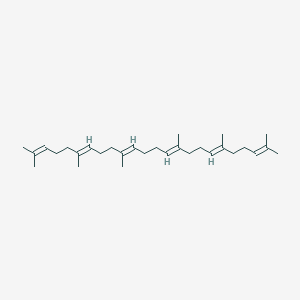-
Categories
-
Pharmaceutical Intermediates
-
Active Pharmaceutical Ingredients
-
Food Additives
- Industrial Coatings
- Agrochemicals
- Dyes and Pigments
- Surfactant
- Flavors and Fragrances
- Chemical Reagents
- Catalyst and Auxiliary
- Natural Products
- Inorganic Chemistry
-
Organic Chemistry
-
Biochemical Engineering
- Analytical Chemistry
- Cosmetic Ingredient
-
Pharmaceutical Intermediates
Promotion
ECHEMI Mall
Wholesale
Weekly Price
Exhibition
News
-
Trade Service
The top academic journal "Cell" recently published an important paper online.
A research team led by Professor Feng Guoping, a professor at the McGovern Brain Institute at the Massachusetts Institute of Technology (MIT) and an academician of the American Academy of Arts and Sciences, unexpectedly discovered that a molecule can Greatly increase the efficiency of CRISPR gene editing tools, and on this basis, developed a new gene editing technology that can be used to study and change disease-causing gene mutations.
"This technological advancement can be used to accelerate the establishment of animal disease models.
More importantly, it opens up a new method to correct disease-causing mutations.
Professor Feng Guoping’s team is committed to studying the mechanisms of neurodevelopment and mental illness.
For this reason, they have created a variety of animal models, introducing genetic mutations that cause human diseases into animals, and allowing genetic mutations to be passed on to the next generation.
The application of gene editing tool CRISPR has greatly helped the creation of such animal disease models.
One method is to inject gene editing tools and DNA fragments carrying specific mutations into mouse embryos.
However, the researchers pointed out that using this method to construct disease models may still take months or even years.
The reason for the inefficiency is that many processed cells do not have the DNA sequence changes that the researchers want at all, and the changes only Occurs in one of two gene copies.
In order to improve the efficiency of the gene editing process, in this research, Professor Feng Guoping's team initially envisioned adding a DNA repair protein RAD51 to the standard CRISPR gene editing tool to allow the target cell-mouse fertilized eggs to be produced as desired.
The desired genetic change.
The researchers tested the autism-related gene Chd2 and inserted a point mutation into the gene.
The results were surprising: the overall proportion of embryos that were correctly edited remained the same, but the proportion of the required gene editing on both chromosomes increased significantly, even reaching 100%.
"Generally speaking, it is very rare to edit two chromosomes at the same time," explained Dr.
Jonathan Wilde, the first author of the study.
As a result, the research team turned to focus on studying the role of RAD51 in gene editing.
After ingenious experimental verification, they found that the reason why RAD51 can enhance gene editing is related to a DNA repair process called "interhomolog repair" (IHR), which refers to one chromosome in a pair of chromosomes.
"Previous studies on IHR have shown that the efficiency of IHR in most cells is very low," Dr.
Wilde said.
"We found that IHR can occur more stably in embryonic cells and is enhanced by RAD51.
This means that with With a deeper understanding of the factors that allow embryos to allow this type of DNA repair, we can design safer and more effective gene therapies.
"
"HDR-based strategies still have the problem of low efficiency, and there is also the risk of unnecessary integration of foreign DNA in the entire genome," Professor Feng added.
"IHR has the potential to overcome these problems because it relies on natural cells.
Pathways and the patient’s own normal chromosomes to correct harmful mutations.
"
This research team is still looking for other DNA repair-related proteins that can stimulate IHR, gain insight into the mechanism of IHR, and finally apply this technology to develop a safer method for gene therapy.
(Academic latitude and longitude)
Reference materials:
[1] Jonathan J.
Wilde et al.
, (2021) Efficient embryonic homozygous gene conversion via RAD51-enhanced interhomolog repair.
Cell DOI: https://doi.
org/10.
1016/j.
cell.
2021.
04.
035
[2] McGovern lab develops new technique for correcting disease-causing mutations.
Retrieved June 1, 2021 from https://mcgovern.
mit.
edu/2021/05/26/mcgovern-lab-develops-new-technique-for-correcting -disease-causing-mutations/
The top academic journal "Cell" recently published an important paper online.
A research team led by Professor Feng Guoping, a professor at the McGovern Brain Institute at the Massachusetts Institute of Technology (MIT) and an academician of the American Academy of Arts and Sciences, unexpectedly discovered that a molecule can Greatly increase the efficiency of CRISPR gene editing tools, and on this basis, developed a new gene editing technology that can be used to study and change disease-causing gene mutations.
"This technological advancement can be used to accelerate the establishment of animal disease models.
More importantly, it opens up a new method to correct disease-causing mutations.
" Professor Feng Guoping commented.
Professor Feng Guoping’s team is committed to studying the mechanisms of neurodevelopment and mental illness.
For this reason, they have created a variety of animal models, introducing genetic mutations that cause human diseases into animals, and allowing genetic mutations to be passed on to the next generation.
The application of gene editing tool CRISPR has greatly helped the creation of such animal disease models.
One method is to inject gene editing tools and DNA fragments carrying specific mutations into mouse embryos.
CRISPR can target specific sequences of target genes to cut, and then use injected DNA fragments to "repair" broken DNA strands.
However, the researchers pointed out that using this method to construct disease models may still take months or even years.
The reason for the inefficiency is that many processed cells do not have the DNA sequence changes that the researchers want at all, and the changes only Occurs in one of two gene copies.
But for most genes, one cell contains two copies of genes from mother and father.
In order to improve the efficiency of the gene editing process, in this research, Professor Feng Guoping's team initially envisioned adding a DNA repair protein RAD51 to the standard CRISPR gene editing tool to allow the target cell-mouse fertilized eggs to be produced as desired.
The desired genetic change.
The researchers tested the autism-related gene Chd2 and inserted a point mutation into the gene.
The results were surprising: the overall proportion of embryos that were correctly edited remained the same, but the proportion of the required gene editing on both chromosomes increased significantly, even reaching 100%.
Subsequent tests on other genes produced the same results.
"Generally speaking, it is very rare to edit two chromosomes at the same time," explained Dr.
Jonathan Wilde, the first author of the study.
"The percentage of editors after joining RAD51 is shockingly high.
"
As a result, the research team turned to focus on studying the role of RAD51 in gene editing.
After ingenious experimental verification, they found that the reason why RAD51 can enhance gene editing is related to a DNA repair process called "interhomolog repair" (IHR), which refers to one chromosome in a pair of chromosomes.
It uses another chromosome as a template to repair broken DNA.
In contrast, current standard gene therapy strategies usually rely on homology-directed repair (HDR), which uses injected foreign DNA fragments as repair templates.
"Previous studies on IHR have shown that the efficiency of IHR in most cells is very low," Dr.
Wilde said.
"We found that IHR can occur more stably in embryonic cells and is enhanced by RAD51.
This means that with With a deeper understanding of the factors that allow embryos to allow this type of DNA repair, we can design safer and more effective gene therapies.
"
"HDR-based strategies still have the problem of low efficiency, and there is also the risk of unnecessary integration of foreign DNA in the entire genome," Professor Feng added.
"IHR has the potential to overcome these problems because it relies on natural cells.
Pathways and the patient’s own normal chromosomes to correct harmful mutations.
"
This research team is still looking for other DNA repair-related proteins that can stimulate IHR, gain insight into the mechanism of IHR, and finally apply this technology to develop a safer method for gene therapy.
(Academic latitude and longitude)
Reference materials:
[1] Jonathan J.
Wilde et al.
, (2021) Efficient embryonic homozygous gene conversion via RAD51-enhanced interhomolog repair.
Cell DOI: https://doi.
org/10.
1016/j.
cell.
2021.
04.
035
[2] McGovern lab develops new technique for correcting disease-causing mutations.
Retrieved June 1, 2021 from https://mcgovern.
mit.
edu/2021/05/26/mcgovern-lab-develops-new-technique-for-correcting -disease-causing-mutations/







